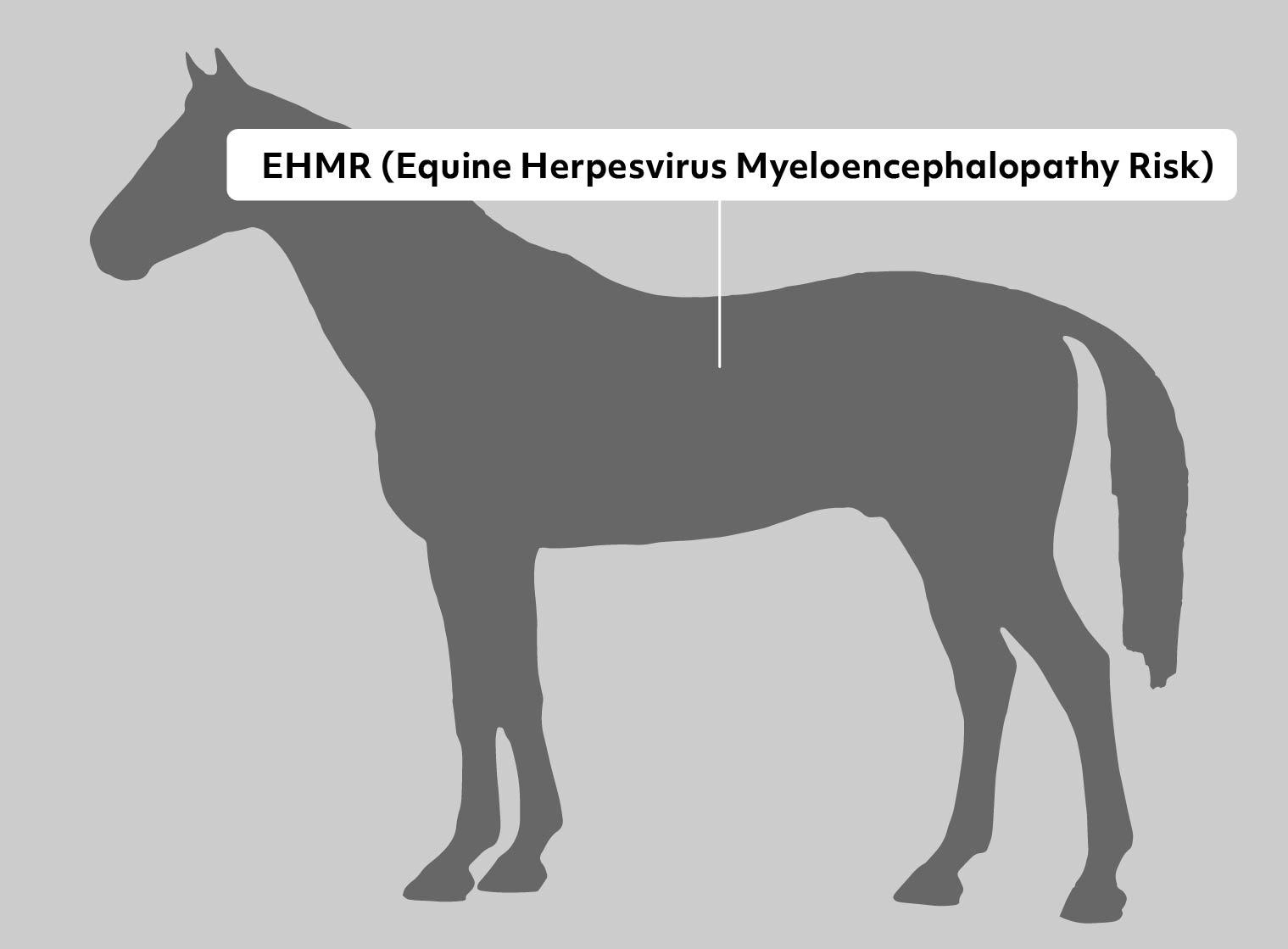Equine Herpes Virus Type 1 & Induced Myeloencephalopathy (EHV-1 / EHM)
Gene or Region: intron of TSPAN9
Reference Variant: G
Mutant Variant: A
Affected Breeds: Diverse breeds from the US, Canada and Europe
Research Confidence: Discovery - Findings require expanded validation
Explanation of Results: EHMR/EHMR = homozygous for EHV-1 Induced Myeloencephalopathy Risk, 1.43x increased risk EHMR/n = heterozygous for EHV-1 Induced Myeloencephalopathy Risk, 1.43x increased risk n/n = no variant detected
Equine Herpesvirus (EHV-1) and Myeloencephalopathy (EHM): Understanding Risks, Symptoms, and Prevention
EHV-1 stands for Equine Herpes Virus type 1. Equine herpesviruses are DNA viruses that are found in horses all over the world, the majority of which will have no serious side effects. EHV-1 can cause four manifestations of disease in horses, including the neurological form, respiratory disease, abortion, and neonatal death.
Equine Herpesvirus Myeloencephalopathy (EHM) is the neurologic disease associated with Equine Herpes Virus type 1 (EHV-1), representing one outcome of infection. This occurs to a subset of infected horses and its symptoms are painful and sometimes fatal. Neurologic signs result from inflammation of the blood vessels, blood clots, and death of neurologic tissue. EHM can affect one or multiple infected horses in a group.
After infection, the incubation period is typically 4-6 days, but may be as short as 24 hours. EHV-1 typically causes a two-phase fever peaking on day 1 or 2 and again on day 6 or 7. Respiratory infections often present nasal and ocular discharge, and minimal coughing. There may also be some persistent enlargement of lymph nodes under the jaw. The neurologic form of EHV-1 (EHM) presents with minimal respiratory signs, and fever (rectal temperature greater than 101.5 degrees F) is considered a warning sign. Sudden neurologic disease progresses rapidly and reaches peak intensity within 24 to 48 hours from onset of initial neurologic signs. Horses may develop EHM even without any preceding fever and/or respiratory signs. Clinical signs of EHM may include:
-In-coordination -Hind limb weakness -Loss of tail tone -Lethargy -Urine dribbling -Head tilt -Leaning against a fence or wall to maintain balance -Inability to rise
EHV-1 is contagious and spread by direct horse-to-horse contact via the respiratory tract through nasal secretions. It is important to know that this virus can also be spread indirectly through contact with physical objects that are contaminated with the virus, including but not limited to: human contaminated hands or clothing, contaminated equipment and tack, contaminated trailers used for transporting horses, contaminated wipe rags or other grooming equipment, or contaminated feed and water buckets. The air around the horse that is shedding the virus can also be contaminated. Although it is known that the virus can be airborne, it is difficult to establish the spread distance under typical horse management and environmental conditions.
A genome-wide association study (GWAS) investigated host genetic variations associated with EHM, resulting in a variant (BIEC2_946397) within an intron of the tetraspanin 9 (TSPAN9) gene, which is expressed in endothelial cells and platelets, correlated with a recessive protective effect against EHM in EHV-1 affected individuals. Understanding the contribution of host genetic variation to the development of EHM can help with strategies for treating individual cases and managing outbreaks.
Learn More about EHM and the genetic test for increased risk on our blog.
References
Brosnahan, M. M., Al Abri, M. A., Brooks, S. A., Antczak, D. F., & Osterrieder, N. (2019). Genome-wide association study of equine herpesvirus type 1-induced myeloencephalopathy identifies a significant single nucleotide polymorphism in a platelet-related gene. The Veterinary Journal, 245, 49-54. https://doi.org/10.1016/j.tvjl.2018.12.013
More Horse Health
Lordosis
Lordosis (L1, L2, L3, L4), also known as "Swayback", is a curvature or dip in the spine that is often seen in older horses. However, in the American Saddlebred, this condition also affects younger horses. These animals do not appear to experience pain from their condition and are still able to be used under saddle.
Malignant Hyperthermia
Malignant hyperthermia (MH) is a muscle disorder in which anesthesia, stress, or extreme exercise trigger a hyperthermic state. Symptoms include high temperature, increased heart rate, high blood pressure, sweating, acidosis, and muscle rigidity. If symptoms are not immediately resolved, death is likely to occur.
Myosin-Heavy Chain Myopathy
Myosin-Heavy Chain Myopathy (MY; previously "IMM") is a genetic muscle disease found most commonly in stock-type horses that can result in two different presentations, Immune-Mediated Myositis (IMM) and Nonexertional Rhabdomyolysis “tying up,” which are both characterized by muscle damage or loss. Both presentations are associated with the same genetic variant. Horses with MYHM may exhibit one or both presentations at different times in their lives, although some horses carrying the variant might not display any symptoms at all.
Myotonia
Myotonia (MYT) is a rare disorder involving a slowed relaxation of muscles after contraction. The most well-known example of myotonia is “fainting goats,” a breed that is characterized by sudden rigidy and/or falling over when startled. In the single documented horse, this resulted in a protruding third eyelid when excited, as well as problems with muscle stiffness.
